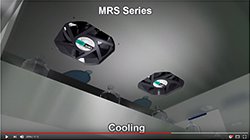These axial fans have an expected life of 100,000 hours (about 11 years). They reduce the increase in bearing temperature, inhibit grease deterioration and improve vibration resistance and shock resistance through bearing enlargement. They also increase the life of circuits and couplers and reduce failure rate. They are designed based on the concept of initial failure so that random failure and wear-out failure will not occur, allowing for 100,000 hours of continuous operation or more (survival rate of 90% or higher).
Long-life axial fans have an expected life of 100,000 hours, so the number of cooling fans that need replacing is decreased compared to conventional models.

*1 - The conventional models are T-MRS16-BTA-G and MRS16-BTA. The long-life fan is MRE16-BBHG.
*2 - Estimated life of 35000 hours with an ambient temperature of 60°C (140°F). Estimated life is an estimated value calculated using the bearing life-of-grease formula. Estimated life is different for each model.
Low Speed Alarm Types
An alarm is output when the fan speed drops due to the service life of the fan or ingress of foreign objects. This makes it possible to order and replace the fan with a new one before it stops.
If multiple cooling fans are being used, it is possible to only replace the cooling fan with decreased cooling capacity. Even if the cooling capacity of the fan decreases, the effect on the equipment can be minimized.

Fan Kits Available

Thermostat Available for Energy Saving
Thermostats (sold separately) make it possible for fans to operate only when cooling is necessary. Thermostats provide energy-saving by automatically stopping fans for example, at night, when the amount of heat generation declines following the load rate's decline in equipment, or in winter, when the ambient temperature drops and forced cooling is not necessary.













